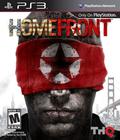Kaos Studios is no stranger to games set in the near future. Their last game, Frontlines: Fuel of War was built around the idea of an oncoming energy crisis, something that may not be too far off. It presented a disturbingly chilling look into a potential future energy war, where familiar nations have splintered or allied in their attempts to capture the world's remaining fuel supplies. The sequel, Homefront, is set in the future, 20 years from now. The world is in pretty terrible shape. Energy concerns have become paramount, and for some unexplained reason, the face of the world's military has changed. How much as it changed? Homefront takes place in an America that has been completely conquered ... by North Korea. When asked, the developers mentioned that how North Korea managed to occupy the U.S. would be part of the game's plot, but it certainly was odd to see North Korea being presented as the #1 threat to American existence.
The only people fighting the North Korean occupiers are the members of the Resistance, scattered pockets of patriotic Americans who are trying to take back their country. If all this sounds very much like "Red Dawn," there is certainly a reason for it: John Milius, a writer for "Red Dawn," is also penning Homefront. Players take the role of Connor Macey, a member of the Resistance. For some reason, Connor is the main target of the North Korean soldiers, and as our E3 demo opened up, he had wandered into a Resistance camp in Colorado. The entire band of Resistance fighters is planning to evacuate just because Connor has shown up.
The demo began very slowly. Connor woke up and was given a guided tour of the small Colorado stronghold by one of the soldiers. The city was a weird combination of survivalist planning and modern design. All of the buildings and houses were pure suburbia, although many seemed to have been damaged or stripped for parts. As the guide explained how the Resistance was planning to evacuate, we saw a number of signs that this was not a comfortable suburban town. There were discussions of limited power supplies and the difficulty in getting clean water. Resistance members were abundant and heavily armed, but so were children and infants. Despite this, it seemed to be a fairly self-sufficient place, and the implication was that Connor's mere presence had destabilized what appeared to be a thriving community.
After being guided into a building and introduced to one of the Resistance's futuristic machine guns, the calm was shattered as the North Korean army arrived in full force. From here, Homefront's gameplay transitioned into that of a more traditional first-person shooter. The North Koreans were launching assaults with bombers and ground troops, and Connor's goal was to escape. The firefight was fierce, and what really stood out was the art direction and detail. Tossing grenades into windows would make the windows deform with the explosion, enemies would duck behind cover, and troops yell and form makeshift barricades as North Korean bombers swoop overhead. In general, it felt like a real mess. The gameplay felt very much like your traditional first-person action title, with Connor moving slowly and using his advanced machine gun to blow the living daylights out of any unfortunate North Koreans who got in his way.
One of Homefront's interesting features is the "Drama Engine." Since the areas are large and wide open, it's rather difficult to keep the action focused entirely on the player. This is where the Drama Engine comes into play. The game will naturally work to focus the events happening around your player, instead of your player going through events. A few examples of this occurred during the demo. At one point, an out-of-control jeep went rampaging through the area just in front of us, clearly intending to almost run over the player. In another, an RPG-wielding enemy blew up a car just next to Connor, stunning him for a moment and pointing us toward a dangerous enemy. It was tough to tell in the demo exactly what was and wasn't an influence of the Drama Engine, but the scenes that we saw felt very natural and smooth, and it all integrated very well with the basic gameplay.
The crowning moment of the demo was the reveal of the Goliath remote-controlled tank. It's the secret weapon the Resistance, and their last hope to escape the North Korean assault. This was revealed when Connor grabbed a small laser sight attachment for his gun. When he aimed the laser sight at a target, a tremendous tank/jeep hybrid burst from its hiding place and drove toward it. By aiming the laser pointer, he could guide the Goliath to drive over enemies or to provide a defensive barrier against enemy fire. He could even use the Goliath's built-in mini-gun. It proved to be a very effective weapon indeed, and it seemed as if nothing the North Koreans could bring forth could stand against it.
Unfortunately, right about here was where our Homefront demo ended, but we got a few more tidbits of information after the demo. Connor will be able to drive any vehicle in the game at some point, which seems to include even the tremendous North Korean bombers. There will be some form of multiplayer, but no information was available yet. All in all, Homefront was a very interesting demo. While the gameplay looked fun enough, what really stood out was the art direction and intensity of the battle scenes. It looked and sounded a lot like war had come to suburbia, and it created a great game tone. The inexplicable North Korean occupiers came across as a very efficient fighting force. All we can really say about Homefront at the moment is that it looks to be a very pretty game, and it's a solid first-person shooter, but hopefully more details will arise to fill in some of the blanks.
More articles about Homefront











 Homefront is set 10 years after the economic collapse of the United States and follows the American Civilian Resistance as they fight to reclaim their homeland from an oppressive North Korean occupation, featuring a personal, story-driven single player campaign and a full suite of multiplayer options.
Homefront is set 10 years after the economic collapse of the United States and follows the American Civilian Resistance as they fight to reclaim their homeland from an oppressive North Korean occupation, featuring a personal, story-driven single player campaign and a full suite of multiplayer options.





